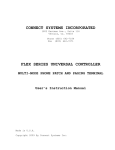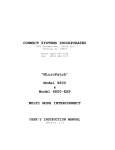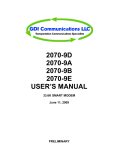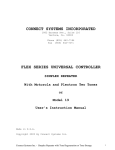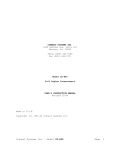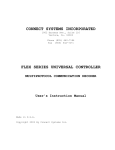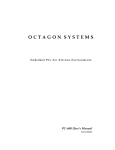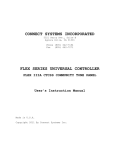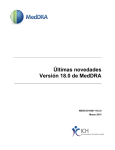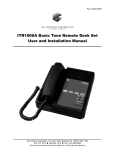Download Siemens V2.03 Users Manual
Transcript
CONNECT SYSTEMS INCORPORATED 1802 Eastman Ave., Suite 116 Ventura, Ca. 93003 Phone (805) 642-7184 Fax (805) 642-7271 FLEX SERIES II UNIVERSAL CONTROLLER MULTIMODE INTERCONNECT AND EIA TONE REMOTE E&M VERSION User’s Instruction Manual Made in U.S.A. Copyright 2003 By Connect Systems Inc. CONNECT SYSTEMS INCORPORATED 1802 Eastman Ave., Suite 116 Ventura, Ca. 93003 Phone (805) 642-7184 Fax (805) 642-7271 FLEX SERIES UNIVERSAL CONTROLLER MULTIMODE INTERCONNECT AND EIA TONE REMOTE E&M VERSION User’s Instruction Manual Version 2.03 Made in U.S.A. Copyright 2003 By Connect Systems Inc. Made in U.S.A. Connect Systems Inc. - Model FLEX II Page 2 TABLE OF CONTENTS General Description CONNECTIONS ADJUSTMENTS JUMPER STRAP OPTIONS GENERAL PROGRAMMING INFORMATION DIFFERENT PROGRAMMING AREAS PROGRAMMING FIELDS Fields That Have Two Possibilities Fields That Have A Require A Value Setting all parameters back to factory default GLOBAL PROGRAMMING PARAMETERS Operation General Circuit Description Warranty FCC Notice to users Connect Systems Inc. - Model FLEX II 4 5 8 10 12 12 14 14 14 16 17 24 29 32 33 Page 3 GENERAL DESCRIPTION The FLEX SERIES II MULTIMODE INTERCONNECT AND EIA TONE REMOTE by Connect Systems Inc. is a fully automatic Multi-Mode radiotelephone interconnect terminal. A built-in LCD digital display allows the user to obtain the maximum power from the onboard microprocessor. All features are user programmable and/or selectable. This version of the Flex series Universal Controller has separate single ended and balance input and outputs. The balanced input and outputs can be configured for two wire full duplex or half duplex operation or four wire balanced audio allowing the user to hook up to a simplex radio or hook up to a duplex radio operating in either the half duplex mode or full duplex mode. All other hardware features of the product remain the same as the previous version of the FLEX SERIES UNIVERSAL CONTROLLER. The balanced audio is on a separate four terminal screw type of barrier strip. The rest of the signals are on a single ten position terminal screw type of barrier strip. This software for this version of the Flex Series is proprietary to Siemens although it does use some of the software in the standard product. The EIA factory: tones will High level Guard Tone Function Tones Low level Guard Tone have the following levels preset at the 10 dBm (2.4500 Volt into 600 ohm load) 0 dBm ( .7750 Volt into 600 ohm load) -20 dBm ( .0775 Volt into 600 ohm load) These as well as other settings and the programmable factory defaults will be preset at the factory to minimize the effort needed to install the product in your environment. Designed and built with pride in the U.S.A. Connect Systems Inc. - Model FLEX II Page 4 THE CONNECTIONS (PRIMARY TEN POSITION CONNECTOR) RX AUDIO For the products detecting CTCSS, DCS, or LTR, or products that use the internal squelch, the RX AUDIO must be connected to the discriminator of the radio. For all other products the RX AUDIO can be connected to the discriminator, high side of the volume control, or the speaker. TX AUDIO For products that generate CTCSS, DCS, or LTR, the TX AUDIO must be connected directly to the modulator of the transmitter. For LTR and DCS, the modulator must be true FM. For CTCSS the modulator can be phase modulated or FM modulated. For all other applications, connections to the high side of the microphone is acceptable. It should be noted that in most communication controllers there is a separate line for voice audio and a separate line for the CTCSS, DCS, or LTR signals. This is because to combine the two the controller has to have a limiter on the voice line to prevent over modulation and other undesirable side effects. The Flex Series Controllers has a built in limiter thereby not requiring separate lines. PTT The PTT normally hooks to the PTT of the transmitter. If you are using a Hand Held with the PTT sharing a common connection with the transmit audio, then attach a resistor with a value between 2.4K and 4.7K from the PTT to the TX Audio and attach the TX audio line to the center conductor of the microphone cable. In most product that use the PTT, the AUX relay can also be used as a PTT connection. This has the advantage of allowing positive keying or other situations where the normal open collector PTT does not work. COS Connect to a point that has a good voltage swing when the squelch is opened/closed. The best point to connect is to the collector of the transistor that controls the busy light (if the receiver has one). Otherwise you may connect to the squelch control voltage. The minimum voltage for the COS is about 0 volts and the Maximum voltage is the supply voltage. Some radios have that point coming out the back of the radio. It sometimes goes under the name of squelch detect, sq det, or COR. In some case a pull up or pull down resistor is necessary. Connect Systems Inc. - Model FLEX II Page 5 The polarity and other parameters associated with the COS is contained within the programming parameters described later. It should be noted that in most cases, the COS can be replaced with the internal squelch. SENSE This point is used as an auxiliary input for specialized purposes in certain products. As an example, this input may be used to detect the presence of a CTCSS/DCS signal in an LTR system. The minimum voltage for the sense input is about 0 volts and the Maximum voltage is the supply voltage. The polarity and other parameters associated with the SENSE is contained within the programming parameters if used. AUX RELAY These two points connects to the center contact and normally open contact of the relay. The use if any depends upon the product. +12 VDC Connect to a source of 12 volts to 15 volts DC. The Flex Series Controllers are reverse polarity protected, so a polarity mistake will not damage the product. Connect the return lead to ground. The two grounds in the system are connected to each other. THE CONNECTIONS (SECONDARY TEN POSITION CONNECTOR) 4W RX+ 4W RX- Only used in four wire mode for audio in. 4W RX/TX+ In four wire mode, provides the audio out. In two wire 4W RX/TX- mode, provides both audio in and audio out. CT VOLT This is a center tap to the transmitting transformer on the secondary side of the transformer (side attaching to the radio). This will only be used in the four wire mode. MONITOR+ Provides a monitor function from the receiver. This is a buffered output and is transformer coupled to provide isolation and a balanced output. MONITOR- Provides other side of balanced output. Should be connected to ground connection if single ended output needed. DIG IN Digital input to provide monitoring of negative voltages with respect to ground. Designed for -48 Volts. Connect Systems Inc. - Model FLEX II Page 6 D/A OUT Spare output to be used for undefined functions for future applications. GROUND Ground for D/A output THE CONNECTIONS (RJ11 TELCO CONNECTOR) L->M Pins 2 & 5. Provides audio between the telephone and the transmitter of the radio M->L Pins 3 & 4. Provides audio between the receiver of the radio and the telephone line. CONTROL Pins 1 & 6. Provides a pair of uncommitted relay contacts to allow the signaling function of an E&M Type 1 protocol. THE CONNECTIONS (RJ11 PROGRAMMING CONNECTOR) PROGRAM Pins 3 & 4. A standard telephone plugs into these wire and is used for programming. RS485 Pins 2 & 5. Used for connecting multiple units together for an integrated system. DIG IN Pin 1. Used as a uncommitted digital input for future expansion. Connect Systems Inc. - Model FLEX II Page 7 ADJUSTMENTS P1 HYB BAL The Hybrid Balance control is used to null out the mobile return audio in full duplex mode. The alignment must take place on one of the phone lines the Flex Series controller will be serving. (This alignment can not be done at the shop prior to delivery to the site.) Have a mobile place a call through the Flex Series Controller. The party answering the called phone should leave the phone off hook during the alignment procedure. Monitor the transmitter output with a service monitor or connect an oscilloscope to the "TX OUTPUT" terminal on the rear of the Flex Series Controller. Place all four Dip switches in the off position. Have the mobile simultaneously press digits 3 and 6 on his touch tone keypad. This will result in the transmission of a single 1477 Hz tone. Adjust the "HYB BAL" Potentiometer to produce the least audio output. Try all possible dip position combinations and null each time. The combination which gives the minimum output is the correct position to use. Changes made within the telephone company or rerouting of telephone lines could occasionally require re-adjustment of the hybrid. P2 Hyb Bal 2 The Hybrid Balance control is used to balance the balanced audio coming from or to the radio. This is only necessary for the repeater operating in the full duplex mode on a two wire system. If a four wire system is used, then it is not necessary to balance the hybrid. P3 Tel Vox Used for detection of call progress tones and sensitivity to voice in Vox operated applications. Turning the pot clockwise increases its sensitivity. P4 Preamp The preamp control is used to match the audio level from your receiver to the Flex Series controller. To adjust, a signal containing 100 Hz CTCSS with about 600 Hz deviation should be applied to the receiver. Adjust the preamp control until a level of 3 volts peak to peak is observed at test point Connect Systems Inc. - Model FLEX II Page 8 6. If an oscilloscope is not available, read 1 volt RMS using a VOM. P5 RX VOX Used in VOX mode only. Sets RX audio triggering sensitivity. Should be fully clockwise in VOX simplex applications. Reduce setting when used through repeaters if land line cannot respond to mobile during hang time due to noise or tone on the repeater carrier. P6 AUDIO OUT Adjust the maximum level going to the transmitter. When turned fully clockwise, an output voltage of about five volts peak to peak is obtained. In most case the output level can also be set in the programming mode. P7 CONTRAST Sets the contrast of the LCD. Adjust to what is most pleasing to the individual. P8 SQUELCH Advance clockwise to a point just beyond where the front panel display "Rx" message disappears. Not all products will display the Rx message. Connect Systems Inc. - Model FLEX II Page 9 JUMPER STRAP OPTIONS JP1 Line In Use Detector. When inserted, enables line in use detection. That allows the system to detect if another phone in parallel with the controller is off hook. Will only work with a phone system where the nominal on hook voltage is about 48 volts. JP2 Preamp Gain. With no jumper installed, gain is 100. With the jumper connected to the bottom two pins, the gain is about 10 with a .0047 uF capacitor giving 3 db cutoff of xxx Hz. With the jumper connect to the two pins, the gain is about 10 with a .047 uF capacitor giving a 3 db cutoff of xxx Hz. JP3 JP4 JP5 JP6 JP7 JP8 JP9 JP10 TO TO TO TO TO TO TO TO JP11 Bypass High Pass Filter JP12 RS232 TX from UART or port pin JP13 RS232 RX to UART of port pin JP14 Allows D/A output to go Shares pin with aux relay. JP15 The terminating resistor when used communication. Only use one per system. JP16 When inserted, allows the TX Audio output to be DC coupled. JP17 Select between single ended and balance audio from receiver. JP18 Allows flat audio to be selected from radio with gain of 100. JP19 Allows the voice storage chip to receive directly from the radio or the telephone. JP25 Not on board BE BE BE BE BE BE BE BE DETERMINED DETERMINED DETERMINED DETERMINED DETERMINED DETERMINED DETERMINED DETERMINED to primary connector. for RS485 audio SETTING THE JUMPERS TO SELECT BETWEEN DIFFERENT RADIOS Connect Systems Inc. - Model FLEX II Page 10 For the four wire balanced audio without center tap, insert the following jumpers: JP23,JP24,JP30. For the four wire balanced audio with the center tap transformer, insert the following jumpers: JP26, JP27, JP30. For two wire balanced audio, insert JP20,JP21,JP22,JP24,JP28,JP29,JP30 Connect Systems Inc. - Model FLEX II the following jumpers: Page 11 PROGRAMMING INFORMATION This section on programming shows the different programming fields that are available across the many different FLEX SERIES UNIVERSAL CONTROLLER product lines. Not all these fields will be used in a particular product. This paging terminal can be programmed four different ways... Locally, remotely over the air, remotely from any touch tone phone, or through a computer. The computer programming will not be available in the near future. Local Programming: Simply plug any DTMF telephone set into the rear panel RJ-11 jack labeled "PROG". This allows the telephone keypad to act as a programming keyboard. The front panel display will show either the keystrokes or the results of the keystrokes. DTMF Over the Air Programming: The paging terminal can be programmed over the air from any DTMF equipped radio. A DTMF sequence is transponded in response to each command you enter and is used to display the results of your programming on our CD-2 or a special version of the Flex Series Controller. Remote Dial Up Telephone Programming: Occasionally the paging terminal will be located out of radio range and over the air programming will not be possible. Simply dial up the paging terminal to do the programming. You can perform all the programming functions remotely that you can do locally. If the programming sequence is accepted, a DTMF sequence is transponded in response to each command you enter and is used to display the results on a special version of the Flex Series Controller. If the command entered is invalid, three beeps will be generated to tell the user a mistake has been made. Computer Programming: This self contained program operating in the windows environment will allow the user to easily make changes to the characteristics of the paging terminal. This program is not expected to be released till something next year. This programming can be accomplished by using a laptop or other computer and plugging into the front panel plug or by attaching a modem into the back panel plug. If a modem is used, the unit can be programmed remotely. (This feature will not be available on the first release) To Enter and Exit Programming Mode: To enter the programming mode, you must enter the programming mode access code. The access code consist of six digits plus two leading pound "##" characters and a trailing pound character. The factory default programming access code is 123456. The programming access code is always six digits in length. Therefore the code to get into the programming mode is ##123456#. This code will be valid until you have changed the Programming Mode Access Code in the GLOBAL programming area. Connect Systems Inc. - Model FLEX II Page 12 When programming is completed, send ##### to exit the programming mode. If you forget, the Paging terminal is designed is designed to self exit a few minutes after the last DTMF command. Command Syntax: When programming, you will enter a programming sequence such as *0000#03#1#. All commands start with a "*" and end with a "#". There may be one or more additional "#" to act as a delimiter between fields. Leading zeros: Data fields require that you enter the precise number of digits specified. Numbers that have fewer digits than the field requires can use leading zeros. Resetting your position: If you are distracted or have a lapse and forget where you are in the middle of a command sequence, simply send * three times (***) and start the sequence over again. Displaying the field: All the fields can be displayed by the command *nnnn#nn*. The data followed by the # key is replaced by a single star. If system is being programmed by a telephone plugged into the back of the unit, the system will display the results on the internal LCD display. If the system is being programmed remotely by DTMF over the radio, then the DTMF string representing the field will be sent back over the radio. If the system is being programmed remotely by DTMF over the telephone, then the DTMF string representing the field will be sent back over the telephone. If the system is being programmed by a computer, then the results will be sent back over the RS232 connector located in the from and the back of the unit. Different Areas: The programming of the system can be broken up into different areas. The first area which all products have is called the “Global Programming Area”. Depending on the product, different areas may be used such as the “Speed Calling Area” or the “Speed Dialing Area.” The details will be described below. Connect Systems Inc. - Model FLEX II Page 13 DIFFERENT PROGRAMMING AREAS GLOBAL PROGRAMMING AREA The global programming area is used to program parameters that is common to the entire product. All Global Programming commands start with *0000#. An example is *0000#01#J# VOICE PROMPT AREA The voice prompt area is used to enter a voice message. This area is active in all products but not all products use the voice prompt capability. For recording, the format used is *7000#n#0#. The value n corresponds to one of the eight voice memory locations whose maximum record time is as follows: N Maximum Record Time 0 1 2 3 4 5 6 7 9 seconds 9 seconds 9 seconds 9 seconds 9 seconds 25 seconds 25 seconds 25 seconds The total record time for this product is two minutes. To play back, use the command *7000#n* When recording, the system will stop recording either when the maximum time has expired of the user enters any DTMF key. Connect Systems Inc. - Model FLEX II Page 14 PROGRAMMING FIELDS THAT HAVE TWO POSSIBILITIES If the field is in the form of *nnnn#nn#J# such as the TELCO PROGRAMMING field which is *0000#01#J#, then the user must enter the value of 0 or 1 for the field. Any other number will be rejected. In most cases, J = 0 means disable the function and J = 1 means enable the function. PROGRAMMING FIELDS THAT REQUIRE A STRING OF NUMBERS If the field is in the form of *nnnn#nn#N..NN# sucb as the PROGRAMMING MODE ACCESS CODE field which is *0000#05#NNNNNN#, then the user must enter in a number for each of the characters. Some fields require all the numbers to be entered and some fields may only require one or more characters to be entered. PROGRAMMING FIELDS THAT REQUIRE A VALUE If the field is in the form of *nnnn#nn#MMM# such as the TURN ON DELAY field which is *0000#08#MM# or the DTMF TELCO LEVEL field which is *0000#11#MMM#, then the user must enter anywhere from one to three characters, depending on the field and the value must be in the range specified. Some fields allow a range of values and also the value of zero. There is no need for leading zeros. Connect Systems Inc. - Model FLEX II Page 15 SETTING EVERTHING BACK TO FACTORY DEFAULT If for some reason it is necessary to set the system back to factory default, plug a telephone into the programming jack in the back of the unit and enter the command "**123456**. If the system is enabled to accept programming command from other sources such as over the radio, this command is valid from those sources too. You cannot disable the factory reset from working over the local programming jack. Connect Systems Inc. - Model FLEX II Page 16 GLOBAL PARAMETERS TO PROGRAM | V TO DISPLAY | V Programming Parameters TELCO PROGRAMMING *0000#01#J# *0000#01* J = 0 = Disabled J = 1 = Enabled Default = 1 When enabled, the controller will allow a person to call in via the telephone and program the various parameters. If disabled, the phone line will never answer. RADIO PROGRAMMING *0000#02#J# *0000#02* J = 0 = Disabled J = 1 = Enabled Default = 1 When enabled, the controller will allow the parameters to be programmed by radio. If disabled, the controller will ignore any attempt to program the parameters via radio. PHONE PROGRAMMING *0000#03#J# *0000#03* J = 0 = Disabled J = 1 = Enabled Default = 1 When enabled, the controller will allow the parameters to be programmed by a telephone plugged into the programming port in the back of the controller. If disabled, the controller will ignore any attempt to program the parameters via a telephone plugged into the back of the controller. COMPUTER PROGRAMMING *0000#04#J# *0000#04* J = 0 = Disabled J = 1 = Enabled Default = 1 When enabled, the controller will allow the parameters to be programmed by a telephone plugged into the programming port in the back of the controller. If disabled, the controller will ignore any attempt to program the parameters via a telephone plugged into the back of the controller. PROGRAMMING MODE ACCESS CODE *0000#05#NNNNNN# *0000#05* NNNNNN = 000000 - 999999 Default 123456 Code must be precisely six digits. This code is used to enter the programming mode from all sources. Level Control DTMF TELCO LEVEL *0000#06#MMM# *0000#06* MMM = 0 - 255 Default = 255 This is the level the DTMF will be transmitted over the telephone line. Used for remote programming. DTMF RADIO LEVEL MMM = 0 - 255 *0000#07#MMM# Connect Systems Inc. - Model FLEX II *0000#07* Default = 50 Page 17 This is the level the DTMF will be transmitted over the radio. Used for remote programming. BEEP RADIO LEVEL *0000#08#MMM# *0000#08* MMM = 0 - 255 Default = 50 This is the level annunciating beeps will be heard over the radio. BEEP TELCO LEVEL MMM = 0 - 255 This is the level telephone. *0000#09#MMM# annunciating beeps will be *0000#09* Default = 50 heard over the TELCO TO RADIO LEVEL *0000#10#MMM# *0000#10* MMM = 0 - 255 Default = 255 This is the level telephone audio will be transmitted over the radio. RADIO TO TELCO LEVEL *0000#11#MMM# *0000#11* MMM = 0 - 255 Default = 255 This is the level radio audio will be sent over the telephone. RADIO LIMIT LEVEL *0000#12#MMM# *0000#12* MMM = 0 - 255 Default = 255 This is the maximum level the repeater or the telephone audio will be transmitted over the radio. EIA TONE LEVEL *0000#13#MMM# *0000#13* MMM = 0 - 255 Default = 85 This is the level the EIA tones will be sent over the radio. EIA LOW GUARD TONE LEVEL *0000#14#MMM# *0000#14* MMM = 0 - 255 Default = 12 This is the level the EIA guard tones will be sent over the radio. EIA HIGH GUARD TONE LEVEL *0000#15#MMM# *0000#15* MMM = 0 - 255 Default = 255 This is the level the EIA guard tones will be sent over the radio. VOICE RADIO LEVEL *0000#16#MMM# *0000#16* MMM = 0 - 255 Default = 50 This is the level the voice prompts will be heard over the radio. VOICE TELCO LEVEL *0000#17#MMM# *0000#17* MMM = 0 - 255 Default = 50 This is the level the voice prompts will be sent over the telephone. COS/SQUELCH Parameters COS OR INTERNAL SQUELCH *0000#18#J# J = 1 = INTERNAL SQUELCH, J = 0 = COS Selects the source of the squelch. Connect Systems Inc. - Model FLEX II *0000#18* DEFAULT = 0 Page 18 COS POLARITY SELECT *0000#19#J# *0000#19* J = 1 = positive, J = 0 = negative Default = 1 If set for a positive voltage, then any voltage above the COS Trigger Voltage will set COS true. If set for a negative voltage, then any voltage below the COS trigger voltage will set COS true. There is a one half volt hysterises built in. COS TRIGGER VOLTAGE *0000#20#MMM# *0000#20* MMM = 0 - 255 Default = 128 This is the trigger point that will cause the COS to be active. See application note to determine how to calculate the COS trigger voltage. COS ACQUISTION TIME *0000#21#MM# *0000#21* MM = 0 - 99 in 1 millisecond increments Default = 0 This parameter is the time COS must be valid before the system will consider the signal is valid. This is to prevent noise from trigger the system COS RELEASE TIME *0000#22#MM# *0000#22* MM = 0 - 99 in 10 millisecond increments Default = 10 This parameter is the time COS must be invalid before the system will consider the signal no longer valid. This is to prevent picket fence signals from distorting the system Sense Parameters SENSE POLARITY SELECT *0000#23#J# *0000#23* J = 1 = positive, J = 0 = negative Default = 0 If set for a positive voltage, then any voltage above the SENSE Trigger Voltage will set SENSE true. If set for a negative voltage, then any voltage below the SENSE trigger voltage will set SENSE true. There is a one half volt hysterises built in. SENSE TRIGGER VOLTAGE *0000#24#MMM# *0000#24* MMM = 0 - 255 Default = 128 This is the trigger point that will cause the SENSE to be active. See application note to determine how to calculate the SENSE trigger voltage. SENSE ACQUISTION TIME *0000#25#MM# *0000#25* MM = 0 - 99 in 1 millisecond increments Default = 0 This parameter is the time SENSE must be valid before the system will consider the signal is valid. This is to prevent noise from trigger the system SENSE RELEASE TIME *0000#26#MM# *0000#26* MM = 0 - 99 in 10 millisecond increments Default = 10 This parameter is the time SENSE must be invalid before the system will consider the signal no longer valid. This is to prevent picket fence signals from distorting the system Connect Systems Inc. - Model FLEX II Page 19 RX Vox Parameters RX VOX ACQUISTION TIME *0000#27#MM# *0000#27* MM = 0 - 99 in 1 millisecond increments Default = 0 This parameter is the time VOX must be valid before the system will consider the signal is valid. This is to prevent noise from trigger the system RX VOX RELEASE TIME *0000#28#MM# *0000#28* MM = 0 - 99 in 100 millisecond increments Default = 10 This parameter is the time VOX must be invalid before the system will consider the signal no longer valid. This is to prevent temporary lapses in conversation from changing the mode. TX Vox Parameters TX VOX ACQUISTION TIME *0000#29#MM# *0000#29* MM = 0 - 99 in 1 millisecond increments Default = 0 This parameter is the time VOX must be valid before the system will consider the signal is valid. This is to prevent noise from trigger the system TX VOX RELEASE TIME *0000#30#MM# *0000#30* MM = 0 - 99 in 100 millisecond increments Default = 10 This parameter is the time VOX must be invalid before the system will consider the signal no longer valid. This is to prevent temporary lapses in conversation from changing the mode. OPERATING MODE SELECTION OPERATING MODE M = 0 - 2 This parameter follows: *0000#31#M# determines the mode the *0000#31* Default = 0 interconnect is in as 0 = VOX 1 = Half Duplex 2 = Full Duplex VOX MODE PARAMETERS RxVOX OR CARRIER CONTROL *0000#32#J# *0000#32* J = 0 = Carrier, J = 1 = RxVOX Default = 1 Select RxVOX for operation through remotely located repeaters or simplex. Select CARRIER for simplex operation only. In CARRIER, the telephone party cannot key the base transmitter while the mobile is talking. VOX ACTIVITY *0000#33#MM# MM = 0 – 99 in 1 minute Increments Connect Systems Inc. - Model FLEX II *0000#33* Default = 0 Page 20 This feature determines how long the system will stay connected if there is no vox from either the telephone or the radio. If set for 0, the function is disabled. VOICE DELAY FROM TELEPHONE *0000#34#NN# *0000#34* MM = 0 - 40 Delay in 10 millisecond increments Default = 40 Sets the amount of voice delay in 10 millisecond increments from the telephone line to the radio. In VOX mode, word clipping or word loss is directly proportional to radio T/R speed in simplex systems and repeater pick up time when used through repeaters. The slower the system, the more desirable voice delay becomes. The voice delay electronically delays audio originating from the telephone by 0 to .4 second. This in effect means that the transmitter has been keyed for .4 second before the audio even began! This timing makes word loss virtually impossible. The voice delay is essential when using the Flex Series Controller through repeaters from a Control Station. It is also recommended for use in straight VOX simplex mode operation especially when connected to a slow switching base station radio. VOICE DELAY FROM RADIO *0000#35#NN# *0000#35* MM = 0 - 40 Delay in 10 millisecond increments Default = 40 Sets the amount of voice delay in 10 millisecond increments from the radio to the telephone line. This allows the telephone user to hear the entire conversation from the radio if the system is not active at the current time. SENSE, VOX, OR TONE CONTROL *0000#36#N# *0000#36* N = 0 - 4 Default = 0 If set to zero, the PTT and EIA tone will be controlled by the Sense Input or the PTT. If the sense is active or the telephone Vox is active, then the PTT and EIA tones will be generated. If the PTT is inactive and the Sense is inactive, the system will be in receive mode and the PTT will be turned off. If set to one, the PTT and EIA tones will be controlled only by the Sense Input. If set to two, the PTT and EIA tones will be controlled only by the VOX from the telephone. If set to three, the PTT and EIA tones will be controlled by functions *8 and *9 If set to four, the PTT and Aux Relay (depending on programming) and CT relay (depending on programming) will be controlled by functions *8 and *9. There will be no EIA tones generated. Connect Systems Inc. - Model FLEX II Page 21 TELEPHONE AND OTHER PARAMETERS TURN AROUND DELAY *0000#37#N# *0000#37* N = 1 – 9 (1-9 seconds) Default = 3 seconds Access delay is a user selectable delay to compensate for PTT hang after pressing a DTMF key on mobile and portable radios. Select a value that allows you to hear all of the DTMF from the programming mode without losing any characters. TURN ON DELAY *0000#38#N# *0000#38* N = 0 – 99 (0-99 mSec) Default = 20 mSec Delay from the time the PTT is asserted to the time the radio is stable enough to transmit voice or data. TURN OFF DELAY *0000#39#N# *0000#39* N = 0 – 99 (0-.99 seconds) Default = 0 seconds Guard band from the time voice or data is transmitted to the time the PTT could be released. DIGITAL INPUT POLARITY *0000#40#J# *0000#40* J = 0 – 1 Default = 0 If J = 0, then a request to go off-hook will require -48 volts. If J = 1, then a request to go off hook will require a ground. CONTROL RELAY POLARITY *0000#41#J# *0000#41* J = 0 - 1 Default = 0 When the switch asserts the digital input as defined above, the relay will close if J = 0 and open if J = 1. E-DELAY PBX *0000#42#MM# *0000#42* MM = 1 – 99 (10-990 mSec) Default 400 mS This parameter is only used for PBX originated calls. When the M lead is asserted with -48 volts, the E lead (relay) does not turn on until the time specified in this parameter. E-DELAY REC *0000#43#MM# *0000#43* MM = 0 – 99 (.1 – 9.9 Sec) Default 0 This parameter is only used if the call originated as a result of receive VOX. This relay asserts the E lead (relay) and keeps the system in talk cycle for a minimum of the time specified. At the end of the time specified, the system will disconnect (release the E-Lead) if the M lead has not been asserted before that time. Once the M lead has been asserted, then the system will immediately disconnect if the M lead has been released even if the total time the E lead (relay) has been asserted is less than the time specified by this parameter. If this parameter is set to zero, then the system will stay in talk cycle with the E lead asserted (relay) until the M lead is asserted and then released from talk cycle only when the M lead is Connect Systems Inc. - Model FLEX II Page 22 released. This means the eventually answer the call. operator at the base station must RINGOUT MODE Not Used *0000#44#N# *0000#44* AUTO-ANSWER RING NUMBER Not Used *0000#45#N# *0000#45* RING SPACE Not Used *0000#46#MM# *0000#46* RING-ANSWER Not Used *0000#47#N# *0000#47* RING PULSE COUNTER Not Used *0000#48#MMM# *0000#48* EIA TONES ENABLE *0000#49#J# *0000#49* J = 1 = Enable, J = 0 = Disable Default = Enable If disabled, the EIA tones defined below for tone remote operation will not be used. FUNCTION 8 SELECT *0000#50#J# Spare. Incorporated in parameter 36. *0000#50* RADIO SELECT ENABLE *0000#51#J# *0000#51* J = 1 = Enable, J = 0 = Disable Default = Disable If Enabled, a COS or VOX will enable the controller by asserting the control relay as defined in parameter 42. If Disabled, the controller will not turn on unless it gets a valid signal on the DIGITAL INPUT as defined in parameter 41. AUX RELAY MODE *0000#52#N# *0000#52* N = 0 - 3 Default = 0 The auxiliary relay can be used in one of four modes. When N is equal to zero, the auxiliary relay is never used. When N is equal to one, then the auxiliary relay will be pulled in whenever the PTT is asserted. When N is equal to two, the auxiliary relay will be pulled in whenever the channel is active and released when ever the channel goes back to the idle mode. When N is equal to three, the auxiliary relay will be controlled by the DTMF function code. CENTER TAP RELAY MODE *0000#53#N# *0000#53* N = 0 - 3 Default = 0 The center tap relay can be used in one of four modes. When N is equal to zero, the center tap relay is never used. When N is equal to one, then the center tap relay will be pulled in whenever the PTT is asserted. When N is equal to two, the center tap relay will be pulled in whenever the channel is active and released when ever the channel goes back to the idle mode. When N is equal to three, the center tap relay will be controlled by the DTMF function code. Connect Systems Inc. - Model FLEX II Page 23 OPERATION CALLING FROM THE TELEPHONE LINE The system is waiting for a ringing voltage on the telephone line. There is a programmable feature that requires a minimum number of transitions at the ringing frequency before it can be considered a valid ringing signal and will be answered. The user can select the number of rings that must occur before the system will answer. Once the system has answered, the system operates in either vox or carrier mode. If the auto answer ring number is set to zero, then the controller will not recognize any ringing and therefore will do nothing upon an incoming signal. CALLING FROM THE RADIO The system is always looking for audio from the radio via its radio vox circuitry. When the system sees a valid radio vox signal, the system turns on the telephone relay which in turn alerts the operator at the console. The length of time the VOX has to be valid is a programmable feature. This is a programmable feature that can be disabled. VOICE DELAY FROM BOTH THE RADIO AND THE TELEPHONE. When the system is idle, there is a voice delay (programmable time) from the radio to the telephone. This allows up to 400 milliseconds second for the system to detect the voice via vox, close the line relay, and allow the phone system to patch the radio to the console. This delay will stay in effect until the voice buffer is clear and there is no more voice from the radio or the dispatcher turns on the PTT. At that point the delay will be from the telephone to the radio to account for the Vox and the turn on delay of the radio. In a simplex system, whenever the system is not transmitting, the audio from the radio is always going to the telephone line thereby eliminating the need for any voice delay from the radio to the telephone. THE TALK CYCLE Once the line relay has closed, the system goes into the talk cycle and the mobile and the operator can speak to each other. There are five modes that the talk cycle can take, depending on parameter 36. In the following discussion, depending on the programming of other parameters, when ever the PTT is turned on, the Aux and/or the CT relay will turn on and the EIA tones will be generated. When the PTT is turned off, the Aux and/or the CT relay will turn off and any EIA tones will be turned on. Whenever EIA tones are turned on, the last EIA tone selected via the *1 - *7 will determine the turn on sequence. If no EIA tones have been Connect Systems Inc. - Model FLEX II Page 24 selected, then the system will use the function *1 as the default. The full definition of the EIA tones is described later. Mode 0: In this mode, the PTT is controlled by both the sense input and the telephone VOX. When either the Sense Input is active or the telephone VOX is active, the PTT will be asserted. To go back to the receive mode, both the Sense Input and the telephone VOX has to be inactive. If parameter 49 (EIA tones enable) is enabled, then the EIA tones will be generated whenever the PTT is asserted. If the parameter is disabled, then no EIA tones will be generated. Mode 1: In this mode, the PTT is controlled only by the sense input. When the sense input is active, then PTT will turn on and when the sense input is inactive, the PTT will turn off. If parameter 49 (EIA tones enable) is enabled, then the EIA tones will be generated whenever the PTT is asserted. If the parameter is disabled, then no EIA tones will be generated. Mode 2: In this mode, the PTT is controlled only by the telephone VOX. When the telephone VOX is active, the PTT will turn on and when the telephone VOX is inactive, the PTT will turn off. If parameter 49 (EIA tones enable) is enabled, then the EIA tones will be generated whenever the PTT is asserted. If the parameter is disabled, then no EIA tones will be generated. Mode 3: In this mode, the PTT is controlled by the DTMF being received over the telephone lines. When the user presses the *8, the PTT turns on and when the user presses the *9, the PTT turns off. This mode will work only if parameter 49 (EIA tones enable) is turned on. Mode 4: In this mode, the PTT is controlled by the DTMF being received over the telephone lines. When the user presses the *8, the PTT turns on without any EIA tones and when the user presses the *9, the PTT turns off without any EIA tones. This mode will work only if parameter 49 (EIA tones enable) is turned on. CALLING FROM A CONSOLE VIA THE SENSE INPUT Once the system is active, the PTT can be activated via the sense input. The actual value needed for an activation can be between ground and 12 volts. OPERATION OF THE COS OR INTERNAL SQUELCH In the VOX mode, the system can use either the COS/Internal Squelch or the VOX to operate the audio direction. If Carrier operation is selected, then the direction of transmission is determined by the COS or Internal Squelch. If the COS or Internal Squelch is active, indicating the radio is receiving carrier, then Connect Systems Inc. - Model FLEX II Page 25 the audio will be in the direction of the radio to the telephone line, other wise the direction will be from the telephone line to the radio. The PTT will be keyed only when there is audio coming from the telephone. There is a programmable voice delay to account for the delay from the time the audio is spoken until the time the radio is keyed and transmitting. In the half duplex mode, as long as the telephone line is attached, the radio is keyed. The COS or Internal Squelch only determines the direction of the audio. If the COS or Internal Squelch is active, indicating the radio is receiving carrier, then the audio will be in the direction of the radio to the telephone line, other wise the direction will be from the telephone line to the radio. DISCONNECTING FROM THE TELEPHONE LINE The telephone line will disconnect on the following conditions. 1. There is a loss of loop current 2. There is a line reversal 3. There is no VOX activity on either the telephone side and the radio side for at least the time preprogrammed. This parameter can be from 1 - 99 minutes in 1 minute increment or if set to zero will disable the feature. During the last minute before disconnection, the system will generate beeps every five seconds on both the telephone line and the radio to indicate that the disconnection is imminent. PTT AND THE 2175 GUARD TONE Whenever PTT is active, there will also be a 2175 Hz guard tone 30 db lower that the standard tones subject to the protocol given below. This feature and other features defines below can be selected on or off as a programmable feature. VARIOUS EIA FUNCTIONS TONES The system will have the ability to detect DTMF sequences from the telephone line and in turn convert those to EIA function tones with the level and the timing to operate a Motorola Standard Tone Remote board. Because the system is continually watching the DTMF sequences over the telephone line, these sequences will override any other operation that the system is currently performing. If the system is transferring voice from the radio to the telephone line, this DTMF sequence will override the voice and generate the appropriate tones. Also note that by generating those DTMF sequences, the telephone VOX as a consequence will be activated. Once the system operator selects the appropriate function via the DTMF tone sequence, the appropriate EIA tones are generated. Thereafter, every time the system goes from receive to transmit, the same EIA tone sequence will be generated. Connect Systems Inc. - Model FLEX II Page 26 DTMF *1 from the telephone port will cause the Universal Controller to generate 120 ms of 2175 Hz High Level Guard Tone, followed by 40 ms of 1950 Hz F1 Tone followed by 2175 Low Level Guard Tone (at 30 db less that HLGT) until PTT is released. DTMF *2 from the telephone port will cause the Universal Controller to generate 120 ms of 2175 Hz High Level Guard Tone, followed by 40 ms of 1850 Hz F2 Tone followed by 2175 Low Level Guard Tone (at 30 db less that HLGT) until PTT is released. DTMF *3 from the telephone port will cause the Universal Controller to generate 120 ms of 2175 Hz High Level Guard Tone, followed by 40 ms of 1350 Hz F3 Tone followed by 2175 Low Level Guard Tone (at 30 db less that HLGT) until PTT is released. DTMF *4 from the telephone port will cause the Universal Controller to generate 120 ms of 2175 Hz High Level Guard Tone, followed by 40 ms of 1250 Hz F4 Tone followed by 2175 Low Level Guard Tone (at 30 db less that HLGT) until PTT is released. DTMF *5 from the telephone port will cause the Universal Controller to generate 120 ms of 2175 Hz High Level Guard Tone, followed by 40 ms of 1550 Hz F5 Tone followed by 2175 Low Level Guard Tone (at 30 db less that HLGT) until PTT is released. DTMF *6 from the telephone port will cause the Universal Controller to generate 120 ms of 2175 Hz High Level Guard Tone, followed by 40 ms of 1150 Hz ALT-F1 Tone followed by 40 ms of 1950 Hz F1 Tone followed by 2175 Low Level Guard Tone (at 30 db less that HLGT) until PTT is released. DTMF *7 from the telephone port will cause the Universal Controller to generate 120 ms of 2175 Hz High Level Guard Tone, followed by 40 ms of 1050 Hz ALT-F1 Tone followed by 40 ms of 1950 Hz F1 Tone followed by 2175 Low Level Guard Tone (at 30 db less that HLGT) until PTT is released. DTMF *8 from the telephone port DEPENDING ON PROGRAMMING OF THE CONTROLLER, will cause the Universal Controller to generate/simulate the PTT condition immediately by one of two programmable selections: (1) Generate 120 ms of 2175 Hz High Level Guard Tone, followed by 40 ms of 1950 Hz F1 Tone followed by 2175 Low Level Guard Tone (at 30 db less that HLGT) until *9 (PTT) is released OR (2) *8 will cause a closure of the auxiliary relay and *9 will open the auxiliary relay. DTMF *9 from the telephone port Will cancel the PTT condition started (or open the auxiliary relay), and in process, by the DTMF *8. ADDITONAL EIA FUNCTION TONES (Versions 2.07 and later) DTMF #0 from the telephone port will cause the Universal Controller to generate 120 ms of 2175 Hz High Level Guard Tone, Connect Systems Inc. - Model FLEX II Page 27 followed by 40 ms of 1150 Hz ALT-F1 Tone followed by 40 ms of 1850 Hz F1 Tone followed by 2175 Low Level Guard Tone (at 30 db less that HLGT) until PTT is released. DTMF #1 from the telephone port will cause the Universal Controller to generate 120 ms of 2175 Hz High Level Guard Tone, followed by 40 ms of 1150 Hz ALT-F1 Tone followed by 40 ms of 1350 Hz F1 Tone followed by 2175 Low Level Guard Tone (at 30 db less that HLGT) until PTT is released. DTMF #2 from the telephone port will cause the Universal Controller to generate 120 ms of 2175 Hz High Level Guard Tone, followed by 40 ms of 1150 Hz ALT-F1 Tone followed by 40 ms of 1250 Hz F1 Tone followed by 2175 Low Level Guard Tone (at 30 db less that HLGT) until PTT is released. DTMF #3 from the telephone port will cause the Universal Controller to generate 120 ms of 2175 Hz High Level Guard Tone, followed by 40 ms of 1150 Hz ALT-F1 Tone followed by 40 ms of 1550 Hz F1 Tone followed by 2175 Low Level Guard Tone (at 30 db less that HLGT) until PTT is released. DTMF #4 from the telephone port will cause the Universal Controller to generate 120 ms of 2175 Hz High Level Guard Tone, followed by 40 ms of 1050 Hz ALT-F1 Tone followed by 40 ms of 1850 Hz F1 Tone followed by 2175 Low Level Guard Tone (at 30 db less that HLGT) until PTT is released. DTMF #5 from the telephone port will cause the Universal Controller to generate 120 ms of 2175 Hz High Level Guard Tone, followed by 40 ms of 1050 Hz ALT-F1 Tone followed by 40 ms of 1350 Hz F1 Tone followed by 2175 Low Level Guard Tone (at 30 db less that HLGT) until PTT is released. DTMF #6 from the telephone port will cause the Universal Controller to generate 120 ms of 2175 Hz High Level Guard Tone, followed by 40 ms of 1050 Hz ALT-F1 Tone followed by 40 ms of 1250 Hz F1 Tone followed by 2175 Low Level Guard Tone (at 30 db less that HLGT) until PTT is released. DTMF #7 from the telephone port will cause the Universal Controller to generate 120 ms of 2175 Hz High Level Guard Tone, followed by 40 ms of 1050 Hz ALT-F1 Tone followed by 40 ms of 1550 Hz F1 Tone followed by 2175 Low Level Guard Tone (at 30 db less that HLGT) until PTT is released. DTMF #9 from the telephone port will cause the Universal Controller to generate 120 ms of 2175 Hz High Level Guard Tone, followed by 40 ms of 2050 Hz F1 Tone followed by 2175 Low Level Guard Tone (at 30 db less that HLGT) until PTT is released. This is a special for emergency operation for the USPIS. Connect Systems Inc. - Model FLEX II Page 28 GENERAL CIRCUIT DESCRIPTION Telephone Interface Telephone call comes in Telco Jack J1. If the voltage exceeds about 250 volts, the two varistors, V1 and V2 will conduct and blow the two fuses F1 and F2. This protects against lightning and other high voltage transients on the telephone line. If the systems gets a ringing voltage, the optoisolator Q1 will conduct and the output RD1 will present a square wave at the microprocessor whose frequency is the same as the incoming ringing frequency. The microprocessor will determine if it’s a valid ringing signal. The optoisolator Q2 determines if the voltage on the telephone is about 48 volts. If it is the signal LB1 will be grounded. If the voltage goes below about 48 volts that point will be high. When the telephone line is connected and the relay is pulled in, then the two optoisolaters Q3 and Q4 will indicate the presence of loop current and the direction of the current. This circuit allows the system to determine if the phone line has been hung up by a momentary loss of loop current of a reversal of the loop current. The hybrid transformers T1 and T2 along with the balancing network allows the system to separate the receive and transmit audio. This is only necessary in a full duplex phone patch. Receive Telephone Audio The output of T1 is presented to U1D where the Op-Amp provides an anti-aliasing filter to the Voice storage chip U17 and the DTMF decoder U3. The receive telephone audio passes to the Analog to Digital Converter on the microprocessor as the signal AD-TELCO and to the circuitry surrounding U1A where the function of Telephone Vox is implemented. Transmit Telephone Audio The output of the Digital to Analog Converter from the microprocessor (DA_TELCO) is passed to U19 which forms a five pole low pass filter. This circuitry is needed properly reconstruct the data coming from the microprocessor. U1B provides gain before being outputed to the telephone line. Voice Storage Chip The voice storage chip is used to store up to two minutes of voice from either the telephone, programming port, or the radio. The connection from the radio to the voice storage chip is not direct. To accomplish this task, the unit digitizes the voice from the radio and then outputs it to the telephone. If the telephone Connect Systems Inc. - Model FLEX II Page 29 line relay is not pulled in or the system is not connected to the telephone line, then the hybrid is not balanced and the audio to the telephone output will be reflected back to the telephone audio input where it then has a clear path to the voice storage chip. Telephone DTMF Decoder The audio from the telephone is decoded by the DTMF decoder U3. When pin 15 on the DTMF decoder chip is high, it signals to the microprocessor pin that data is waiting where it is then read. Radio Receive Audio U5A provides a low pass filter used to get rid of high frequency garbage from the radio. U5B provides the de-emphasis network. The audio from U5B goes to the RX-VOX, DTMF decoder, zero crossing detector, and the 6 pole high pass filter consisting of U10A, U10B, and U10D. The output of the filter is used to remove sub audible CTCSS,DCS, or LTR tones from the radio before being presented to the microprocessors A/D converter. The receive audio also goes to U13A-U13D, U18A and U18B which is a squelch detector. The squelch detector is used to determine the presence of squelch noise from the radio receiver. Radio Transmit Audio The output of the microprocessors D/A converter is reconstructed by U20, a five pole low pass filter. U4C is used to get rid of any high frequency clock noise from the audio and U4D is used to amplify the results before being presented as transmit audio. BALANCED AUDIO There are two transformers and the appropriate nulling circuitry that allows the radio audio to be either two wire balanced audio or four wire balanced audio. There are jumpers that select between these two configurations. Squelch Detector U13A and U13B act as a four pole high pass filter to remove any low frequency signals below about 11KHz. U13 act as a gain stage where it is then detected by U13D. R110 and C92 act as a smoothing filter where it is then presented to the microprocessor via U18B Zero Crossing Detector U6D and U6C act as a four pole low pass filter designed to pass only the CTCSS, DCS or LTR subaudible signals. U6A and U6B along with the transistors act as a zero crossing detector where it is then presented as a digital signal to the microprocessor. COS Detector U4B acts as a buffer between the outside world converter on the microprocessor. The logic Connect Systems Inc. - Model FLEX II and the within A/D the Page 30 microprocessor determines if the COS should be derived from the COS detector or the Squelch detector. Push To Talk Transistor Q9 acts as a buffer between the microprocessor and the outside world. D14 is used to protect the circuit against any transients. Sense Detector U4A acts as a buffer between the outside world and the converter on the microprocessor. The logic within microprocessor determines the function of that signal. A/D the EEPROM The EEPROM is used for parameter storage and occasionally certain real time data. The part is read and written to by the IIC port on the microprocessor. Computer Interface U12 converts the RS232 levels to levels compatible with the first UART internal to the microprocessor. External Network U16 converts the levels from the second UART built into the microprocessor to the appropriate levels compatible with RS485 communications. This can be used to tie multiple flex series controller together. LCD Interface The microprocessor talks to the LCD controller via a four bit interface. Aux Relay The microprocessor can turn on and off the auxiliary relay by means of a control pin attached to R93. JTAG Interface The microprocessor can be reprogrammed via a JTAG interface. This allows the user to change the characteristic of the controller by means of software available on our web site. Power Supply The power supply generates 12 volts, 5 volts, and 3.3 volts from a 12 volt or greater power source. Connect Systems Inc. - Model FLEX II Page 31 LIMITED WARRANTY Connect Systems Inc. (CSI) hereby warrants our products to be free from defective workmanship for a period of one year and defective parts for a period of one year from date of sale to the initial end user. This warranty applies only to the original consumer/end user purchaser of each FLEX SERIES CONTROLLER. During the first year of warranty, CSI will repair any of its products at no charge providing the defective unit is shipped prepaid and service is performed by CSI. Conventional prevailing labor and shipping charges will apply following the end of the first year. CSI, at its sole discretion, will replace defective parts on an exchange basis for the first year of ownership by the original purchaser. All shipping cost are the responsibility of the customer. What is not covered by this limited warranty: This warranty shall not apply, if, in our judgment the defects are caused by misuse, lightning strikes, customer modification, water damage, negligent use, improper installation, overloads caused by external voltage fluctuations, use of unregulated power supply, damage caused by transit or handling or an abusive treatment not in accordance with ordinary product use or the product serial number has bee removed, altered, or defaced. Specific Exclusion: This warranty specifically excludes lightning protection devices (MOVs and phone line fuses) and transistors in the PTT (Push to Talk) circuitry. These components can only fail from external abuse. THIS WARRANTY IS IN LIEU OF ALL OTHER WARRANTIES, STATEMENTS OR REPRESENTATIONS, AND UNLESS STATED HEREIN, ALL SUCH WARRANTIES, STATEMENTS OR REPRESENTATIONS MADE BY ANY OTHER PERSON OR FIRM ARE VOID. ALL IMPLIED WARRATIES IN CONNECTION WITH THE SALE OF THIS EQUIPMENT, INCLUDING THE WARRANTY OF MERCHANTABILITY, SHALL BE OF THE SAME DURATION AS THE WARRANTY PERIOD STATED ABOVE. SOME STATES DO NOT ALLOW LIMITATIONS OF HOW LONG AN IMPLIED WARRANTY LAST, SO THE ABOVE LIMITATION MAY NOT APPLY TO YOU. IN THE EVENT OF PRODUCT FAILURE WHICH PROVES TO BE CAUSED BY A DEFECT IN WORKMANSHIP OF MATERIALS, YOUR SOLE REMEDY SHALL BE THE REPAIR OF THE DEFECT BY CSI OR ITS APPOINTED REPAIR STATION AS STATION AS STATED IN THIS WARRANTY, AND UNDER NO CIRCUMSTANCES SHALL CSI BE LIABLE FOR ANY LOSS OR DAMAGE, DIRECT, INCIDENTAL, OR CONSEQUENTIAL, ARISING OUT OF THE USE, OR INABILTY TO USE, THIS PRODUCT. SOME STATES DO NOT ALLOW THE EXCLUSION OR LIMITATION OF INCIDENTAL OR CONSEQUENTAL DAMAGES, SO THE ABOVE LIMITATION OR EXCLUSION MAY NOT APLLY TO YOU. If your new CSI product shall ever fail, contact Connect Systems Inc. Customer Service Dept. for repair and warranty information at (805) 642-7184 Note: Connect Systems Inc. reserves the right to render a modest service charge when returned units are found to be free of parts or workmanship defect(s) (i.e. operating to factory specification) within the first year of warranty. Such units will be returned freight collect to the sender, including the appropriate service charge. Connect Systems Inc. - Model FLEX II Page 32 APPENDIX A FCC NOTICE TO USERS ------------------1. This equipment complies with part 68 of the FCC rules. On the bottom of this equipment is a label that contains, among other information, the FCC registration number and ringer equivalence number (REN) for this equipment. If requested, this information must be provided to the telephone company. 2. The REN is used to determine the quantity of devices which may be connected to the telephone line. Excessive REN's on the telephone line may result in the device not ringing in response to an incoming call. In most, but not all areas, the sum of the REN's should not exceed five (5.0). To be certain of the number of devices that may be attached to the line, as determined by the total REN's contact the telephone company to determine the maximum REN for the area. 3. If this product causes harm to the telephone network, the telephone company will notify you in advance that temporary discontinuance of service may be required. But if advance notice isn't practical, the telephone company will notify the customer as soon as possible. Also, you will be advised of your right to file a complaint with the FCC if you believe necessary. 4. The telephone company may make changes in it's facilities, equipment, operations, or procedures that could affect the operation of the equipment. If this should happen, the telephone company will provide advance notice in order for you to make the necessary modifications in order to maintain uninterrupted service. 5. If trouble is experienced with this product, please contact Connect Systems Incorporated at (805) 642-7184 for repair and warranty information. If the trouble is causing harm to the telephone network, the telephone company may request you remove the equipment from the network until the problem is resolved. 6. There are no repairs that can be accomplished by the user. In the event of operation problems, disconnect your unit by removing the modular plug from the telephone company modular jack. If your regular telephone still works correctly, your unit has a problem and should be returned for repairs (in or out of warranty). If upon disconnection of your unit there is still a problem on your line, notify the telephone company that they have a problem and request prompt repair service. The unit may be returned to Connect Systems Incorporated, 2259 Portola Rd. Ventura, CA 93003. Connect Systems Inc. - Model FLEX II Page 33 7. This interconnect product cannot be used on a public coin service provided by the telephone company. Connect to Party Line Service is subject to state tariffs. Contact the state public utility commission, public service commission or corporation commission for information. 8. This device complies with part 15 of the FCC rules. Operation is subject to the following two conditions: (1) This device may not cause harmful interference, and (2) This device must accept any interference received, including interference which may cause undesirable operation. 9. This equipment generates and uses radio frequency energy and if not installed and used properly, i.e. in strict accordance with the service manual, may cause interference to radio or television reception. It has been tested and found to comply with the limits for a Class B computing device pursuant to Subpart J of Part 15 of FCC rules, which are designed to provide reasonable protection against such interference when operated in a residential installation. 10 If this equipment does cause interference to radio or television reception, which can be determined by turning the equipment off and on, the user is encouraged to try to correct the interference by one or more of the following measures: a. Reorient the receiving antenna. b. Relocate the equipment with respect to the receiver. c. Move the equipment away from the receiver. d. Plug the equipment into a different outlet so that equipment and receiver are on different branch circuits. e. Ensure that card mounting screws, attachment screws,and ground wires are tightly secured. connector f. If cables not offered by this company are used with this equipment, it is suggested that you use shielded, grounded cables with in line filters, if necessary. g. If necessary consult your dealer service representative for additional suggestions. 11 The manufacturer is not responsible for any radio or TV interference caused by unauthorized modifications to this equipment. It is the responsibility of the user to correct such interference. Connect Systems Inc. - Model FLEX II Page 34 Changed from Version 2.0 to 2.01 Added Parameters 42 and 43 Changed the default on Parameter 51 to 0 ======================================= Changed from Version 2.01 to 2.02 in Manual Added #0 to #7 to *1 to *9 for possible EIA tone setups. Latest software version 2.07 (April 21, 2004) ======================================= Changed from Version 2.02 to 2.03 in Manual. Added #9 operation for USPIS. Latest version as of March 28, 2005 is version 2.10. This version is used in the USPIS job and is required in all PCB’s currently produced. Can be used in old hardware. Connect Systems Inc. - Model FLEX II Page 35



































